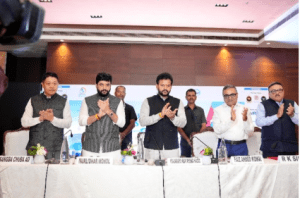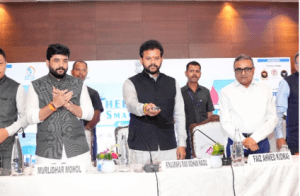Pune/Mumbai, 24 June 2025: The 7th Helicopter & Small Aircraft Summit was successfully held in Pune on Tuesday, bringing together key stakeholders from government and industry to shape the future of India’s aviation landscape. The event, jointly organized by the Ministry of Civil Aviation, Government of Maharashtra, Pawan Hans, and FICCI, was chaired by Union Minister of Civil Aviation Shri Rammohan Naidu Kinjarapu, with Minister of State for Civil Aviation Shri Murlidhar Mohol attending as the Guest of Honor.
Vision for the Future of Indian Aviation
 In his keynote address, Union Minister Shri Rammohan Naidu Kinjarapu emphasized the transformational role helicopters and small aircraft will play in realizing the vision of Viksit Bharat 2047. He declared:
In his keynote address, Union Minister Shri Rammohan Naidu Kinjarapu emphasized the transformational role helicopters and small aircraft will play in realizing the vision of Viksit Bharat 2047. He declared:
“The next decade of aviation will not only belong to large airports and wide-body aircraft, but also to small aircraft and helicopters that connect every citizen with air transport—making flying more inclusive and accessible.”
The Minister underlined the Centre’s commitment to democratizing flying by expanding regional and remote air connectivity. He highlighted that helicopters and small aircraft are essential tools to unlock mobility, healthcare, emergency services, and economic opportunities across the country.
Key Announcements: Helicopter Directorate and Regulatory Reforms
A major highlight of the summit was the announcement of a dedicated Helicopter Directorate within the Directorate General of Civil Aviation (DGCA). This new body will function as a single-window mechanism for all helicopter-related regulatory processes, including:
- Safety and certification issues
- Operator compliance
- Streamlined procedures for registration, route permissions, and slot approvals
The Minister also emphasized the impact of digital innovations like the Heli Sewa Portal, which has significantly reduced paperwork and improved transparency and turnaround times in helicopter operations.
UDAN 5.1 and Seaplane Guidelines: Boost to Connectivity


These reforms are part of a broader strategy to diversify regional aviation, making air travel feasible across challenging terrains, coastal belts, and riverine areas.
Safety and Training: Core to Sustainable Growth
Minister Naidu stressed that safety remains a non-negotiable priority, particularly for routes serving pilgrims and emergency patients. He stated:
“There can be no shortcuts in aviation safety. Communication gaps, operational complacency or misjudgments can cost lives. Our aim is to build a shared culture of discipline, transparency, and proactive safety compliance.”
Minister Murlidhar Mohol: Focus on eVTOL, Green Fuel and Skill Development
Union MoS Shri Murlidhar Mohol, welcoming the industry to Pune, outlined three forward-looking priorities:
- Modernization of air traffic systems
- Green fuel adoption and policy integration of futuristic aircraft such as eVTOLs (electric vertical take-off and landing)
- Massive investment in skill development for pilots, drone operators, and rotorcraft engineers
He reaffirmed the government’s focus on Atma-Nirbhar Bharat, stating:
“India must lead the next wave of aviation evolution—not just as a market but as a manufacturing and innovation hub.”
HEMS: Strengthening Emergency Air Services
One of the summit’s most significant focus areas was the expansion of Helicopter Emergency Medical Services (HEMS). Shri Mohol emphasized that air ambulances are being actively integrated into the national healthcare infrastructure, particularly for remote and hilly regions.
“Access to critical care must not depend on geography. Helicopters can be the difference between life and death in emergencies.”
DGCA and Stakeholder Participation


The summit saw participation from:
- 20 State Governments
- Industry leaders and OEMs
- National Disaster Management Authority (NDMA)
- International Financial Services Centres Authority (IFSCA), GIFT City
- Senior officials from MoCA, DGCA, AAI, and Pawan Hans Ltd
Technical and Policy Sessions: Finance, Safety, and Innovation
The event featured technical sessions on:
- DGCA’s evolving safety frameworks
- Leasing and financing opportunities led by IFSCA
- State government presentations on regional aspirations
- Industry panels on OEM operational challenges, emerging aviation technologies, and local manufacturing potential
Recent regulatory developments like simplified pilot training, streamlined aircraft certification, and seaplane operations framework were also discussed.
A Defining Moment for India’s Aviation Future
The 7th Helicopter & Small Aircraft Summit was more than just a policy conference—it was a strategic milestone for India’s aviation ecosystem. With a renewed focus on connectivity, safety, and sustainability, the Centre aims to integrate helicopters and small aircraft into the mainstream of Indian mobility, healthcare, and economic development.
For more details, check press release on PIB website.
.
For more real-time updates, visit Channel 6 Network.

